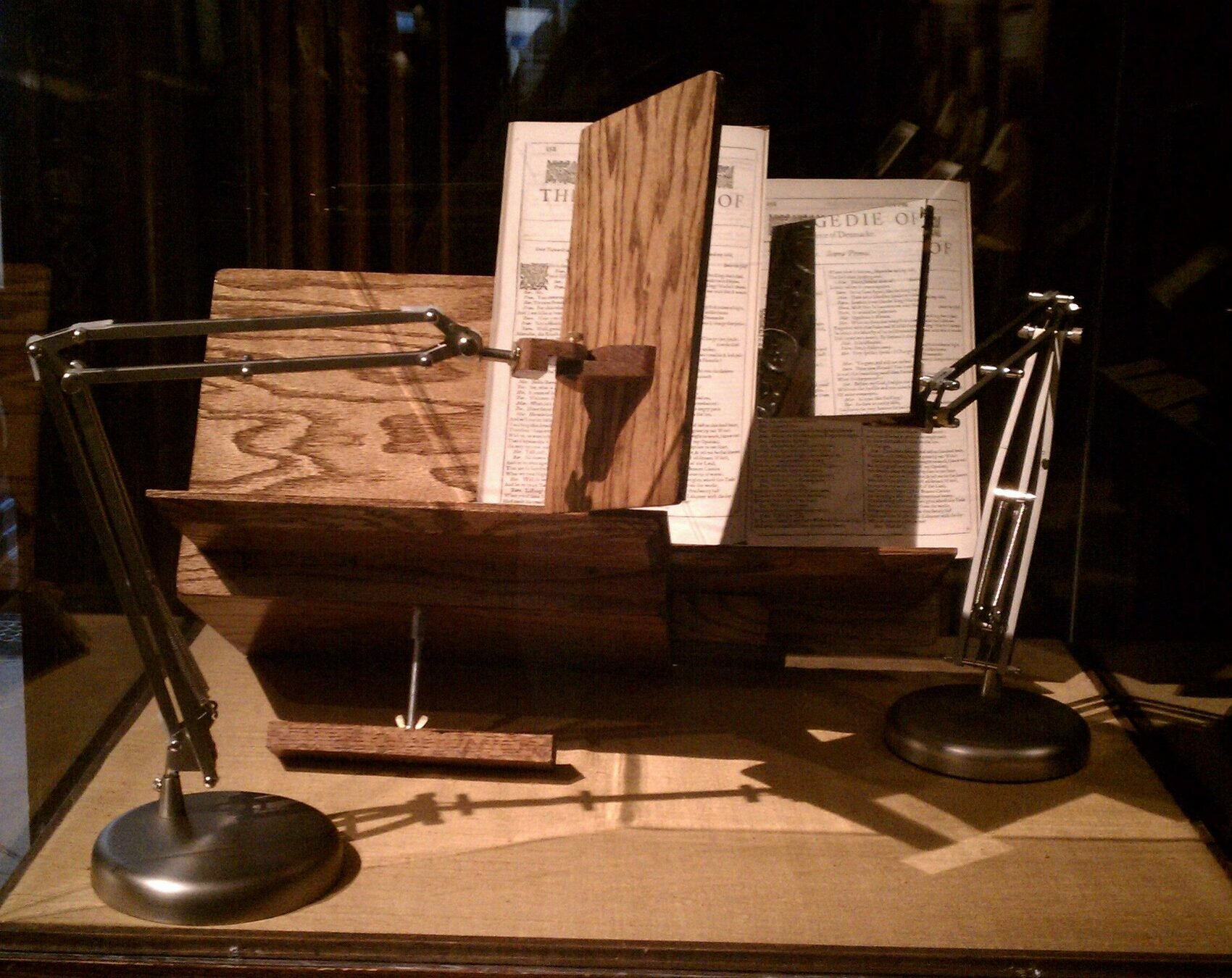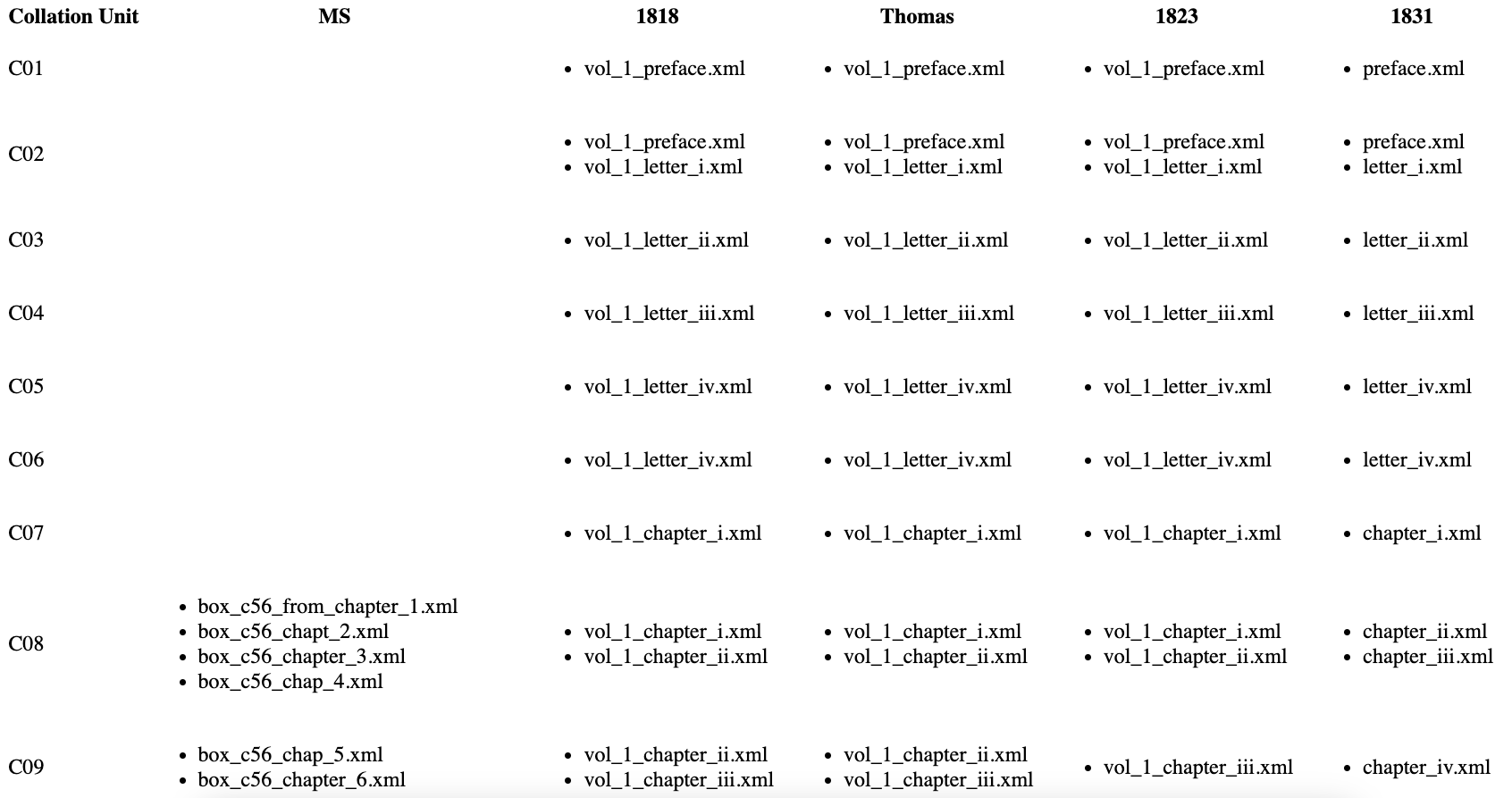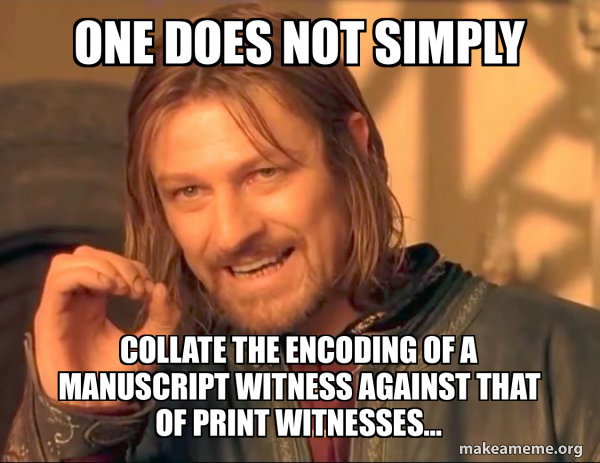Thinking about Collation
Workshop at TEI - MEC 2023, Paderborn
Elisa, Hugh, Torsten, Raff
Slides Link: bit.ly/collThinkSlides
Thinking about Collation
Workshop Notes!

Part 1: Collation: an introduction
Comparing different versions of a text

Carter "Hailey’s Comet" Portable Optical Collator.
Source: https://www.folger.edu/blogs/collation/welcome-to-the-collation/
Tracing version history of a work
Think before you collate
What is your "theory of the text"?
How many texts are you comparing, and on what basis?
What tools can best help you with this comparison?
What constitutes a variant?
(and when collating music notation?)


Automated collation is
an exception
A few things that get weird
Transpositions (on multiple levels)
Friedrich Rochlitz
*1769 in Leipzig
music literate, critic, publisher
witnessed the Battle of Leipzig
in October 1813 (Napoleon vs. most of Europe)
author of “Tage der Gefahr ”
(„days of peril“), 1813 – 1822

Genesis of Tage der Gefahr
- in 1813 Rochlitz started a letter to a friend in Dresden
- the war in Leipzig interrupted all postal services
- Rochlitz continued writing every day
- the letter became a war diary
- after the war he sent the letter/diary to his friend
- the letter was read to many persons
- Rochlitz decided to elaborate and to publish it
- the letter became a biographic novel
- first edition: 1816
- the book was revised and extended
- it became partially fictional
- second edition: 1822
Rochlitz to Böttiger, 1813

„Ich habe in diesen Tagen stündlichen Schreckens und einer Noth, wie wir sie hier noch nicht gekannt, nicht schreiben können …“
First Edition, 1816

Revised Edition, 1822

1814/1822: “A Dream”
a text published in 1814 which was included in the 1822 edition


Stemma
multiple changes of genre → no ideal base text
high degree of variance amongst “versions”

Examples
1816 / 1822: using apparatus seems convenient

Examples
1814 / 1816 / 1822: is an apparatus still the appropriate method?

Some TEI Code
two-level apparatus
level 1: alignment of chunks → focus on similarities
level 2: collation of tokens → focus on differences

chunk level
token level
Digital Edition
one-column presentation, marginal apparatus
→ eternal beta: http://gefahr.elitepiraten.de

Planning a collation project (1/3)
-
What source documents will be used? Are there many witnesses, few, or one? Are the sources relatively close copies or not? (Music: what role will authorial adaptations like piano reductions or orchestrations have in determining variation?)
-
Will there be a single ‘base’ text? Or will witnesses be separately transcribed?
- If a single base text will be used, will it be that of a particular witness, or will the editor attempt to reconstruct an ideal or original text?
about the source documents:
(from the TEI Guidelines Ch. 12 Critical Apparatus)
Planning a collation project (2/3)
- Will each reading in an apparatus entry record every attestation (a ‘positive’ apparatus), or merely witnesses that deviate from the base text (a ‘negative’ apparatus)?
- Will the readings of most or all witnesses be represented in the apparatus, or only a selection the editor deems relevant?
about the identification of reading "witnesses"
(from the TEI Guidelines Ch. 12 Critical Apparatus)
Planning a collation project (3/3)
-
What level of variation will require distinguishing one witness reading from another? For example, will the editor consider an abbreviated word in a witness as agreeing with the base text, or not?
- Will conjectures (variant readings suggested by an editor) be treated differently than readings found in witnesses?
- Will there be a need to distinguish different types of variation, for example orthographic vs. morphological or lexical variants?
about the handling of variation
(from the TEI Guidelines Ch. 12 Critical Apparatus)
Alignment
How can the Guidelines Critical Apparatus chapter better discuss the challenges of alignment?
How is alignment related to describing variants?
Alignment: What constitutes a "same" starting point or ending point for a passage?
Do we need a theory of alignment for our texts?
An alignment challenge in the Frankenstein Variorum
An alignment challenge in the Frankenstein Variorum
Some methods of collation
"Chunking up" the texts in small passages that align via...
- Observation and direct encoding in a critical apparatus
- Chunk/block the texts side by side in columns on a spread sheet
- Get help from software like collateX
Alignment of large units

Alignment of large units

Alignment: smaller scale
<app>
<rdgGrp
n="['<del>and this makes us all very wretched, as much so nearly as after the death
of your dear mother.</del>', 'and this suspicion fills us with anguish.
i perceive that your father <del>conceals</del> attempts to conceal his fears from me;
but cheerfulness has flown from our little circle, only to be restored by a certain assuranance
that there is no foundation for our anxiety. at one time']">
<rdg wit="fThomas"><del rend="strikethrough">and this makes us all very wretched,
as much so nearly as after the death of your dear mother.</del> <add
place="bottom">and this suspicion fills us with anguish. I perceive that your
father <del-INNER>conceals</del-INNER> attempts to conceal his fears
from me; but cheerfulness has flown from our little circle, only to be restored by a
certain assuranance that there is no foundation for our anxiety. At one
time</add></rdg>
</rdgGrp>
<rdgGrp n="['and', 'this', 'makes', 'us']">
<rdg wit="f1818">and this makes us</rdg>
<rdg wit="f1823">and this makes us</rdg>
<rdg wit="fMS"><mod sID="c56-0058__main__d5e11820"/><sga-add
place="superlinear" sID="c56-0058__main__d5e11822"/>and this makes us</rdg>
</rdgGrp>
</app>
<app>
<rdgGrp n="['all']">
<rdg wit="f1818">all</rdg>
<rdg wit="f1823">all</rdg>
</rdgGrp>
</app>
<app>
<rdgGrp n="['very']">
<rdg wit="f1818">very</rdg>
<rdg wit="f1823">very</rdg>
<rdg wit="fMS">very</rdg>
</rdgGrp>
</app>
<app>
<rdgGrp n="['wretched']">
<rdg wit="fMS">wretched</rdg>
</rdgGrp>
<rdgGrp n="['wretched,']">
<rdg wit="f1818">wretched,</rdg>
<rdg wit="f1823">wretched,</rdg>
</rdgGrp>
</app>
When you want to collate markup. . .
About that little problem...

...unless we
- analyze the markup to determine where it meaningfully intersects with the simpler encoding of the print
- ignore what markup has no counterpart in the other witnesses
Machine-assisted collation:
theory and practice
Background image created by Elisa from a picture of a machine loom on Reddit and the frontispiece illustration of Frankenstein (1831)
Machine-aided collation is weaving...

- Source documents supplying “threads”
- collation software = weaving machine
- needs to be able to find where the “threads” run together,
- and where they diverge (and what constitutes divergence)
- Markup functions as signals to the collation weaving machine

Gothenburg model
algorithm for computer-assisted collation, developed in 2009 workshop of collateX and Juxta developers.
-
Tokenization :
-
Break down the smallest unit of comparison: (words--with punctuation, or character-by-character):
-
FV tokenizes words and includes punctuation and tags:
'<del>the', 'frame', 'on', 'whic<del>', 'my', 'man', 'completeed,.'
-
-
Normalization
-
'&' = 'and'
-
<p xml:id="novel1_letter4_div4_p2"> = <p/>
-
-
Alignment
-
Identify comparable divergence: what makes text sequences comparable units?
-
“Chunking” text into comparable passages (chapters/paragraphs that line up with identifiable start and end points). Collation proceeds chunk by chunk.
-
-
Analysis
-
Study output, correct, and re-align after machine process, AND refine automated processing
-
-
Visualization:
-
Critical edition interface, graph displays
-
collateX
Lera
Juxta (no longer a web service)
Some machine-assisted methods
automatic alignment by segments + collation within segments
Tool Presentation: LERA

“Locate, Explore, Retrace and Apprehend complex text variants”
step 1: upload documents
feature: segmentation e.g. by TEI elements or line breaks
Tool Presentation: LERA

step 2: choose documents for alignment/collation (“edition”)
feature: automatic alignment of unaligned segments
Tool Presentation: LERA

step 3: alignment revision and collation configuration
feature: dynamically updated visualizations
Tool Presentation: LERA

step 4: TEI export
Tool Presentation: LERA


Machine assistance or hindrance?
Discuss: Troubles with Gothenburg...
<app xml:id="C11_app11" n="20">
<rdgGrp xml:id="C11_app11_rg_empty">
<rdg wit="#f1831"/>
</rdgGrp>
<rdgGrp n="['henry', '–', 'surely', 'victor']" xml:id="C11_app11_rg1">
<rdg wit="#fMS">
<ptr target="https://raw.githubusercontent.com/FrankensteinVariorum/fv-data/master/2023-variorum-chapters/fMS_box_c56_ch_v_113.xml#C11_app11-fMS"/>
<witDetail wit="#fMS" target="sga:c56/#/p58">
<ref type="page"
target="https://raw.githubusercontent.com/umd-mith/sga/6b935237972957b28b843f8d6d9f939b9a95dcb5/data/tei/ox/ox-ms_abinger_c56/ox-ms_abinger_c56-0058.xml">
<ptr target="https://raw.githubusercontent.com/umd-mith/sga/6b935237972957b28b843f8d6d9f939b9a95dcb5/data/tei/ox/ox-ms_abinger_c56/ox-ms_abinger_c56-0058.xml#string-range(//tei:surface[@xml:id='ox-ms_abinger_c56-0058']/tei:zone[@type='main']//tei:line[8],0,22)"/>
<fv:line_text>Henry – Surely Victor</fv:line_text>
<fv:resolved_text>Henry – Surely Victor</fv:resolved_text>
</ref>
</witDetail>
</rdg>
</rdgGrp>
<rdgGrp n="['henry.', 'surely,', 'victor,']" xml:id="C11_app11_rg2">
<rdg wit="#f1818">
<ptr target="https://raw.githubusercontent.com/FrankensteinVariorum/fv-data/master/2023-variorum-chapters/f1818_vol_1_chapter_v.xml#C11_app11-f1818"/>
</rdg>
<rdg wit="#f1823">
<ptr target="https://raw.githubusercontent.com/FrankensteinVariorum/fv-data/master/2023-variorum-chapters/f1823_vol_1_chapter_v.xml#C11_app11-f1823"/>
</rdg>
<rdg wit="#fThomas">
<ptr target="https://raw.githubusercontent.com/FrankensteinVariorum/fv-data/master/2023-variorum-chapters/fThomas_vol_1_chapter_v.xml#C11_app11-fThomas"/>
</rdg>
</rdgGrp>
</app>Critical apparatus with pointers
Jupyter Notebook exercise
Thinking about Collation
Now, Discussion! Go to the Workshop Notes!

Discussion Topics
1. What special challenges do we encounter in the collation of music—in identification of meaningful variation, determining alignment, etc?
2. When would you want to collate markup or "pseudomarkup" in your projects? Or what kinds of projects might benefit from this?
3. Try out the Jupyter notebook linked in these slides. Where might "machine-assisted collation" be beneficial? Where might it cause problems?
4. What's wrong with machine-assisted collation now? How should it be better? What would it need to do to better work with humanities text / music collation challenges?
Part 2: Modeling the Critical Apparatus
Guidelines Chapter 12
<app>, <lem>, <rdg>, <rdgGrp>, <wit>, <witDetail>, @wit
<app> started out as phrase level, but can contain structures (as of v. 2.9.1, fall 2015)
<app> can nest, so multi-level variation can be handled, but is that enough?
Overview of approaches used in TEI and MEI
- Lachmanian
<tei:app>
<tei:rdg wit="#El">Experience though noon Auctoritee</rdg>
<tei:rdg wit="#La">Experiment thouh noon Auctoritee</rdg>
<tei:rdg wit="#Ra2">Eryment though none auctorite</rdg>
</tei:app>- "Multitext variorum"
<!-- In the document content: -->
<mei:app>
<mei:rdg source="#critApp.source1">
<!-- reading of source 1 -->
</mei:rdg>
<mei:rdg source="#critApp.source2 #critApp.source3">
<!-- reading of sources 2 *and* 3 -->
</mei:rdg>
</mei:app>TEI Guidelines Chapter 12
MEI Guidelines Chapter 11
Overview of approaches used in TEI and MEI
- "Multitext variorum"
- What do we mean?
- No official recommendation from the Guidelines
multiple witnesses to largely the same text
multiple versions
(new editions, reworked material)
text re-use
"Multitext variorum" Stand-off collation

From Early Modern Songscapes: https://ems.digital.utsc.utoronto.ca/
"Multitext variorum" Stand-off collation

Modeling collation (critical apparatus)
Considerations:
- for scholarly research questions: what do you need to investigate?
- for interface development: What can you build with the critical apparatus?
- What can a critical apparatus help you to build and visualize in an edition?
Critical Apparatus Challenges
too many witnesses...
working with data from the critical apparatus...mapping it back to the editions
Discuss!
Choose a topic to discuss in small groups for ~30 minutes.
- Discuss your projects! What are you doing with the critical apparatus?
- What would you like to see in the critical apparatus?
- What would you like to see the TEI provide for expressing variation inline?
- What tooling do we need for document variance modeling?
- What tooling do we need for interface development?